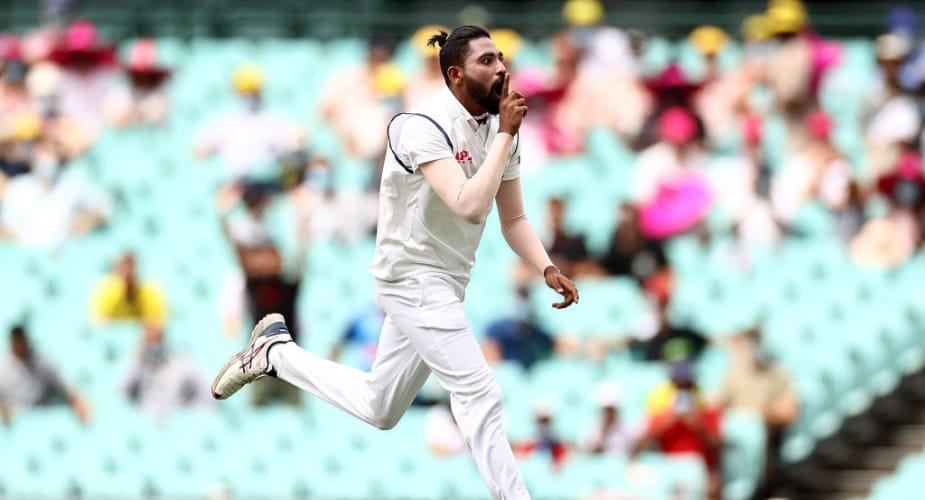The case for Mohammed Siraj in the WTC final XI

India’s frontline quicks have done jaw-droppingly well in Test cricket in the last few years, so much so that Mohammed Siraj, who has had a great honeymoon period in Test cricket, could miss out on the WTC final XI. Rohit Sankar argues why he should play.
Setting up Joe Root to perfection in Ahmedabad, surprising Steve Smith with one that shot up off the surface; if you were an ardent cricket fan in the 90s and woke up from an amnesia two decades later to watch Mohammed Siraj running in full steam, his man bun swinging up and down as he wears a queer frown, you’d be forgiven for punting on him as the No.1 bowler in world cricket.
Siraj’s seamless transition from the domestic grind to international cricket has been a wild dream that ran from Australia to India and now flies west to England as his country prepares for the World Test Championship final.
Yet, the glowing words from teammates and critics could come to nothing on June 18 as his place in the WTC XI is far from a given. Ishant Sharma, Mohammed Shami, and Mohammed Siraj are likely battling for two places with Jasprit Bumrah the assured starter in the pace department.
Why is it difficult to accommodate four seamers?
India’s quick bowlers have been outstanding since the beginning of the last overseas cycle in 2018, the same time Jasprit Bumrah made his Test debut.
The graphic shows that India's quicks have all done extremely well with the ball in this three-year period in the longest format of the game. The tricky bit is the second half of the graphic: the batting averages, most of which hasn't touched double digits.
Having a long tail in England, or any of the SENA nations (South Africa, England, New Zealand and Australia) isn't a recommended move.
Playing four quicks would also mean there's no room for one of the two spinners, Ravindra Jadeja or R Ashwin, both of whom have done really well in the World Test Championship.
How is the Southampton surface?
The WTC final will be played at the Rose Bowl in Southampton. Since the start of 2015, the venue has seen four Test matches with fast bowlers picking up 77.77 percent of the wickets. While the quicks average 28.09 at the venue in these Tests, the spinners average 36.62 with a wicket every 70 balls on an average.
The most recent County game played at the venue was between hosts Hampshire and Leicestershire saw the teams forfeit an innings each after rain intervened to allow for a result, but it still panned out as a draw. Notably, only three overs of spin — all wicketless — were bowled in the entire game.
ICC have allotted an extra day to force a result in case overs are lost in regular play in the first five days of the WTC final. As such, rain might not be a huge factor, but it could influence team selection. There's one more County Championship fixture at the venue in early June, after which the World Test Championship final happens.
Team combination and Siraj's case
If India ditch one of the two elite spinners, it will likely be Ashwin given how Jadeja has transformed into a quality batsman — a batting average of 55.57 in Tests since the start of 2018 — in the last few years. With the tail likely as long as it will be, Jadeja's superior batting ability should see him leapfrog Ashwin to the XI.
But if India decide they need greater batting depth — in which case they might play Shardul Thakur, whose batting ability was on full display in Australia, as the fourth pacer or have Ashwin and Jadeja in the same XI — Siraj would likely be tussling it out with Shami and Ishant for a place in the XI.
Shami and Ishant have been integral parts of India's Test bowling attack in the last three years and Siraj's opportunity in Australia would not have come if all three quicks were available. However, Siraj has grabbed his chance and brings with him a multitude of skills — swing, seam, leg cutters, and reverse swing come naturally to him with the addition of the out-swinger making him a potent threat to either edges of the bat.
The setup of Joe Root on a placid Ahmedabad wicket and the wider release point he used to dismiss Marnus Labuschagne in Australia speaks of a thinking bowler truly aware of the nuances of his skill and having the ability to execute them to perfection.
Ishant has been one of India's most threatening options upfront with the new ball, especially against left-handers. New Zealand have two (Tom Latham and Henry Nicholls), maybe even three (Devon Conway), of them in the top six of their batting line-up. As such Ishant's place is a difficult one to question.
Shami, meanwhile, has been outstanding as a workhorse, but there's still a huge difference between his first and second innings bowling averages (38.76 in the first innings to 19.22 in the second), often a stat pitted against him, in away Tests in the last three years.
Siraj offers a more exciting option that the Kiwis haven't seen quite a lot of. The fast bowler is also riding a crest in the early half of his career. The WTC final could be a massive test for Siraj, but he has already shown he can step up on the big stage.
Subscribe to the Wisden Cricket YouTube channel for post-match awards, player interviews, analysis and much more.

